At noon, we make our way through a narrow alley off Dương Bá Trạc Street (District 8) and stumble into a lively scene of Muslim community life. More than a place of worship, this neighborhood unfolds into a diverse culinary fest, a testament to the cultural crossroads that thrive within the city.
Once a year, this otherwise-quiet alley becomes a hub of activity, welcoming believers as they gather to embrace the spirit of Ramadan.


Taking place in the ninth month of the Hijri calendar, Ramadan is among the most sacred observances in Islam, commemorating the period when the prophet Muhammad received the first revelations of the Quran. For the faithful, it is a time of deep reflection, self-discipline, and spiritual renewal.

Alley 157 on Dương Bá Trạc Street is home to nearly 3,000 Muslims, making it the largest Islamic community in Hồ Chí Minh City. Most residents are members of the Chăm ethnic minority who migrated to the city from outer provinces like An Giang, Ninh Thuận, etc. The area has a long-standing religious history dating back to the establishment of the central Jamiul Anwar Mosque in 1966. The mosque was later renovated into its present form in 2006.


During Ramadan, Muslims fast from dawn to dusk as an expression of devotion, a practice that strengthens willpower and fosters gratitude for daily sustenance. They follow a Halal diet, adhering to Islamic dietary laws prohibiting pork, alcohol, and certain restricted ingredients. Only after sundown do they come together for Iftar, breaking their fast in a shared moment of nourishment and kinship.




To cater to the dining needs of locals, a lively street market specializing in Halal cuisine takes shape around the mosque during Ramadan. Open from 3pm to 6pm, this market operates only during the holy month, offering a variety of home-cooked dishes. Stalls line the walls, showcasing everything from traditional Chăm specialties like curry, roti, and sakaya cakes to popular street foods such as fresh spring rolls and sausages.


The food, prepared in home kitchens, is arranged in generous displays, filling the narrow alley with rich, inviting aromas.
In recent years, the market has welcomed an increasing number of non-Muslim visitors eager to experience Halal food and learn about Islamic customs. Beyond a place for breaking fast, this culinary space serves as a window into a distinct culture and a bridge connecting different communities.
Explore this unique market through the images below:
































